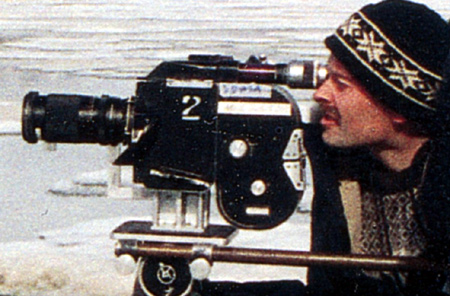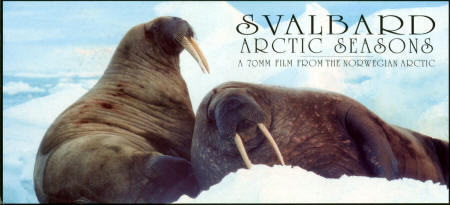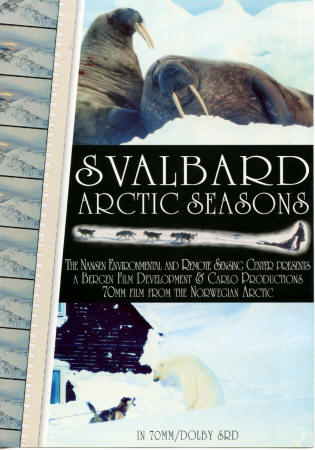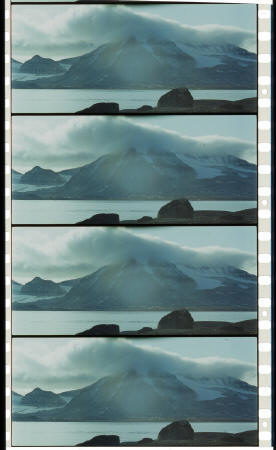Filming of "Svalbard - Arctic Seasons"
|
This article first appeared in |
| Written by: Thomas Hauerslev | Issue 37 - February 1995 |
 Hans
Kristian Bukholm filming with 70mm camera Hans
Kristian Bukholm filming with 70mm cameraA new 70mm film from the Norwegian Arctic is in production. It features the wildlife, spectacular nature and human activities of the archipelago known as Svalbard, which lies to the north of Scandinavia. Svalbard is also called the land of contrasts: the dark, frigid winter, lit only by the northern lights, is followed by long summer days with midnight sun and a burst of wildlife, including birds, reindeer, and walrus. The journey through the arctic seasons also features the life of trappers and scientists in the kingdom of the polar bear. Using light but solid camera equipment and local guides, the small film crew reached remote and unique locations: from the sheer cliffs of the teeming rookeries to the underwater world of seals and icebergs. The rugged mountains, with massive glaciers plunging into the fjords, were filmed from air. |
Further
in 70mm reading: |
 Postcard,
press the image to see enlargement Postcard,
press the image to see enlargementThree shooting periods have been completed; a fourth and final period is scheduled for February 1995. "Svalbard - Arctic Seasons" will premiere in May 1995. Question: Please tell me about yourself. Your previous film experience. Have you filmed in 65mm before? Answer: This is my first production shot entirely in 65mm. It is my 65mm equipment as no other 65mm cameras are available in Scandinavia. My previous experience is mostly in 16- and 35mm from the late seventies while shooting numerous documentaries and television films. I consider myself to be a film- cameraman, avoiding video as much as possible, because of the poor picture quality. During the past 10 years or so I have been working mainly in 35mm doing special effects using classical matte techniques and second unit work. I became involved in anamorphic 35mm in the seventies when I bought my own equipment. I built my own scope system from lenses based on Nikon and Zeiss primes. I had a strong feeling that this 35mm scope format did not give a proper resolution and general appearance. I became aware of 70mm when I saw "Lawrence of Arabia" in 70mm in the Forum cinema in Bergen many years ago. I have felt a strong wish to work with the 70mm format ever since. |
|
 Page
1 of original 4-page flyer, press the image to see enlargement Page
1 of original 4-page flyer, press the image to see enlargementQ: What kind of 65mm camera and stock do you use and what 70mm laboratory do you use? A: The 65mm cameras are of European origin and have been built around a Mitchell type movement. As far as we know only a very limited number were built in the sixties. We also believe these cameras are among the very few left. They take 200ft magazines and the weight is around 10 kilos with film, motor and lens. They are very well suited for remote locations and tough shooting conditions. Before going into production last April, they had to be internally modified and redesigned to a great extent to be able to run 24 fps 65mm/5 perf. One of the cameras is now being modified for "in camera" special effects work (matte shots). We had some problems in the beginning with the film braking near the end of rolls - especially when temperatures got 20 degrees Celsius below 0. After modifying the magazine film take-up system, this problem has been solved. We decided to use Technicolor laboratories in London. We had very easy access to their facilities and so far we are very satisfied with their services. We used the 5245 Eastman 65mm daylight film stock for most of the shooting. |
|
 70mm
frames, press the image to see enlargement 70mm
frames, press the image to see enlargementQ: Why have you chosen to film in 65mm? A: We chose 65mm because the film is going to be shown on a big curved screen, covering more than 100' angle from the audiences point of view. No smaller format could give the same feeling of being present in an arctic environment. Before the decision was made we made some competitive tests on Svalbard, shooting on video, 35mm scope and 65mm. 35mm seemed crisp and clear until the 70mm print from the 65mm negative was shown... I don't think I need to say any more about the subject. Q: How expensive is it to film in 65mm? A: The cost is roughly 2˝ - 3 times as high compared to 35mm. The 35mm scope reduction print alone costs more than a 70mm print! However, 65mm seems to have the function of sharpening the critical taste of the cameraman, leading one to hesitate before pushing the button! We found that even in a wildlife - shooting situation, the general quality on what we got on film became higher than usual. I must mention, however, that budget allowed us to shoot a total of 120 minutes for the whole film! Q: Where can the film be seen? A: "Svalbard - Arctic Seasons" will be shown from 1996 in a specially designed big-screen cinema in the Nansen Remote Sensing Center in Bergen, Norway. We also hope to find an opportunity to show the film abroad. |
|
|
Go:
back
- top
-
back issues Updated 22-01-25 |
